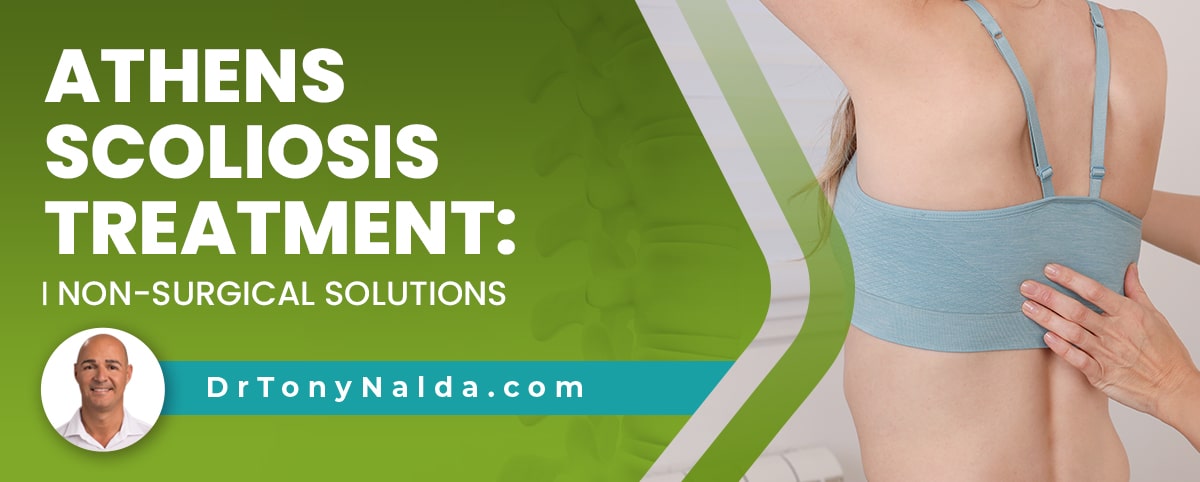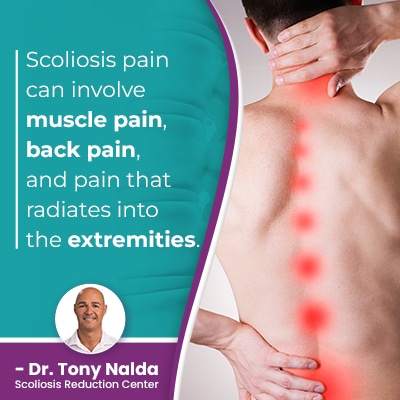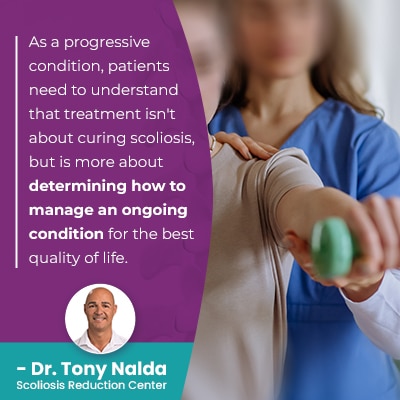Athens Scoliosis Treatment: Non-Surgical Solutions

For those recently diagnosed with scoliosis, it can be a confusing time, particularly because of the condition's complex nature and the fact that we still don't fully understand why most cases of scoliosis develop; we do, however, know how to respond with treatment once a diagnosis is reached.
Athens, Georgia residents can access the Scoliosis Reduction Center's innovative non-surgical treatment approach with a 7-hour drive, or a 1.5-hour flight. Created by Dr. Tony Nalda, renowned scoliosis chiropractor, the Center's non-surgical treatment results speak for themselves.
There are different treatment responses to scoliosis, and when it comes to a non-surgical treatment plan, being proactive is key.
Table of Contents
The Benefits of a Proactive Treatment Response
Scoliosis causes the spine to bend unnaturally to the side and twist, making it a complex 3-dimensional condition.
Scoliosis is also a progressive condition, meaning its nature is to get worse over time, and this means the condition's effects will also become more overt and severe as the condition progresses.
Scoliosis ranges widely in severity from mild scoliosis to moderate, severe and very severe scoliosis, and this is also the condition's progressive line.
Starting treatment early in a condition's progressive line means starting as close to the time of diagnosis as possible; this is because when scoliosis is diagnosed doesn't necessarily mean it has just developed.
When scoliosis is mild, particularly in children for whom the condition is not yet compressive, its effects can be too subtle for anyone, other than an expert trained in what to look for, to notice, hence the benefit of regular screening.
It's a common scenario that patients are diagnosed after a certain amount of progression has already occurred, making the condition's effects more noticeable, and leading to a diagnosis.
Scoliosis is Not a Static Condition
As scoliosis progresses, the condition's uneven forces are increasing, and the spine is becoming increasingly rigid.
As the spine becomes more rigid, it's less malleable and can be less responsive to treatment; a focus of non-surgical treatment involves chiropractic care and therapeutic exercises, and both require a baseline level of spinal flexibility to be effective.
Scoliosis is always changing, and this is why customization of treatment plans is needed, and also why treatment has to be apportioned accordingly based on how the spine responds to treatment and growth (childhood scoliosis).
While we don't know why idiopathic scoliosis develops initially, we know that growth is what makes it progress.
So while there are no treatment guarantees, the benefit of proactive scoliosis treatment is that if early detection has been achieved, early intervention is associated with treatment success.
One of the main effects of childhood scoliosis involve postural changes, and the body's compensations can be impressive, so in most cases, it's more effective to proactively work towards preventing postural changes than it is to attempt to reverse once they've become established.
Postural Changes and Childhood Scoliosis
 Scoliosis affects all ages but is most commonly diagnosed in children; the most prevalent condition type overall is adolescent idiopathic scoliosis diagnosed between 10 and reaching skeletal maturity.
Scoliosis affects all ages but is most commonly diagnosed in children; the most prevalent condition type overall is adolescent idiopathic scoliosis diagnosed between 10 and reaching skeletal maturity.
As scoliosis develops, the condition's uneven forces can disrupt the body's overall symmetry.
For children, often the earliest signs of scoliosis are uneven shoulders and hips, and when mild, these changes can be subtle, and childhood scoliosis isn't commonly painful.
Scoliosis becomes a compressive condition once skeletal maturity has been reached, and it's compression of the spine and its surrounding muscles and nerves that causes the majority of condition-related pain.
Scoliosis pain can involve muscle pain, back pain, and pain that radiates into the extremities.
So for adults, pain is the main symptom that brings them in for assessment, diagnosis, and treatment, and in children, changes to posture are what generally leads to a diagnosis.
Uneven shoulders and hips can also be accompanied by:
- The development of a rib cage arch
- Uneven shoulders blades
- Arms and legs hanging differently
- Clothing becoming ill-fitting
Changes to balance, coordination, and gait are also common.
So the benefit of a proactive treatment response is stronger for children because as a progressive condition triggered by growth, they are the most at risk for continued and rapid progression.
Conservative Treatment for Scoliosis
Conservative treatment for scoliosis is non-surgical and involves integrating multiple different scoliosis-specific treatments into a customized treatment plan.
The complexity of scoliosis necessitates an individualized approach because no two cases are the same.
Not only does scoliosis range so widely in severity, there are also different types a person can develop with different characteristics and treatment needs: idiopathic scoliosis, neuromuscular scoliosis, congenital scoliosis, and degenerative disorders.
There are also different curvature types patterns that treatment plans need to be shaped around.
While surgical scoliosis treatment is still available, the reality is that many cases, particularly those diagnosed and treated early, don't need surgery, and spinal fusion surgery is costly, invasive, and can cost the spine in terms of its natural strength, flexibility, and function.
As scoliosis develops and progresses, it's more than just a simple misalignment, the spine is also twisted, and this doesn't just affect the spine, but also its surrounding muscles, nerves, and the entire body.
A conservative approach uses multiple different types of treatment so conditions can be impacted on every level for the best outcome.
Physical Therapy and Scoliosis Exercises
There was a time when the place of exercise was questioned in the lives and treatment of scoliosis patients; we have since learned that physical therapy and scoliosis exercises have a number of benefits for people living with scoliosis.
Physical therapy and scoliosis-specific exercises can help prepare the spine for treatment by working to restore a certain level of flexibility to make the spine more responsive, and to improve patients' ability to perform key therapeutic exercises as part of treatment.
Physical therapy and scoliosis exercises can also improve the strength and balance of the spine's surrounding muscles; this is a key focus of non-surgical scoliosis treatment as the spine needs to be optimally supported and stabilized.
Chiropractic Care
Condition-specific spinal adjustments and a variety of techniques can work towards realigning the spine and impacting the condition's underlying structural nature.
The goal of the restoration process is to reduce the size of the unnatural spinal curve; this means restoring as much of the spine's natural and healthy curves as possible.
A treatment plan will be 100-percent customized to address the specific curvature type, severity, location, and angle of trunk rotation.
If an unhealthy curve is left untreated, severe health consequences can develop, particularly for older adults as age-related spinal degeneration can make the spine increasingly unbalanced and unstable.
Wearing a Scoliosis Brace
 Wearing a scoliosis brace is common for adolescents with scoliosis, and corrective bracing can be an important facet of childhood scoliosis her at the Center.
Wearing a scoliosis brace is common for adolescents with scoliosis, and corrective bracing can be an important facet of childhood scoliosis her at the Center.
A corrective scoliosis brace can help by pushing the spine into a straighter alignment, and this can also impact postural changes and ensure the head remains level.
A minor bend in the spine can become a moderate and severe bend, so while spines are still growing is the best time to start scoliosis treatment and bracing.
Rehabilitation
A key step of treatment is ensuring that results are held for the long-term.
As a progressive condition, patients need to understand that treatment isn't about curing scoliosis, but is more about determining how to manage an ongoing condition for the best quality of life.
Sometimes scoliosis gradually progresses, but what common happens with children is that growth spurts cause rapid progression that can be difficult to reverse, so working towards prevention has a number of benefits.
Rehabilitation can involve continued chiropractic care, guidance on how to lead a scoliosis-friendly lifestyle, and the prescription of a number of scoliosis exercises designed to help patients further heal and stabilize their spines from home.
Conclusion
Athens, Georgia scoliosis treatment can include Orlando, Florida's non-surgical Scoliosis Reduction Center® with a 7-hour drive, or a 1.5 hour drive.
Through conducting a physical examination that includes an Adams position test, taking a patient's full health history, and x ray results, doctors can assess, diagnose, classify, and treat scoliosis.
The best way to minimize scoliosis symptoms and increasing effects is to treat the condition proactively; this can mean preventing progression, related injuries, and correcting lateral curves on a structural level.
Scoliosis can be highly treatable and doesn't have to limit a person's life or ability, particularly when treated proactively.
Spinal conditions that cause a loss of healthy spinal curves can affect the body in a number of ways, so don't hesitate to reach out for assessment; it can be the first step on the path towards treatment success and an improved quality of life.
Dr. Tony Nalda
DOCTOR OF CHIROPRACTIC
After receiving an undergraduate degree in psychology and his Doctorate of Chiropractic from Life University, Dr. Nalda settled in Celebration, Florida and proceeded to build one of Central Florida’s most successful chiropractic clinics.
His experience with patients suffering from scoliosis, and the confusion and frustration they faced, led him to seek a specialty in scoliosis care. In 2006 he completed his Intensive Care Certification from CLEAR Institute, a leading scoliosis educational and certification center.
About Dr. Tony Nalda
 Ready to explore scoliosis treatment? Contact Us Now
Ready to explore scoliosis treatment? Contact Us Now





